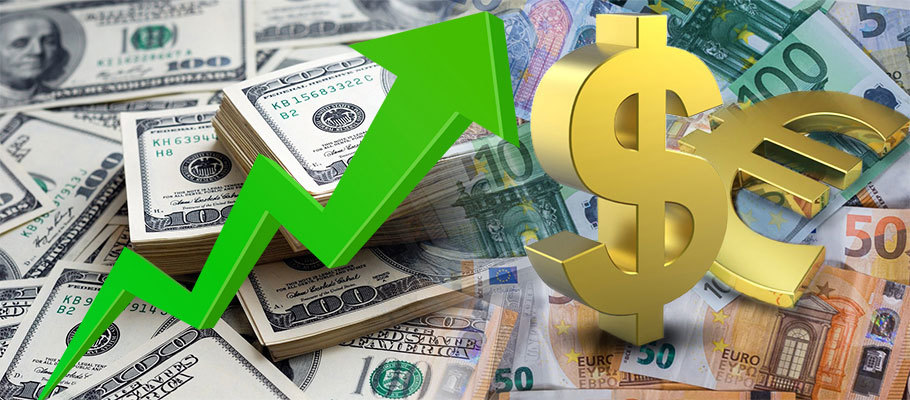
Published: March 12th, 2021
The euro-to-dollar rate was on the rise at mid-week as the greenback and government bond yields fell back sharply from recent peaks.
That was in contrast to Monday’s action, where Europe's single currency was part of a bigger sell-off triggered by data showing German industrial production fell below economist’s expectations. It stayed just above its 200-day moving average of 1.18, however, and has been stable since.
Currency analysts believe that may turn out to be the setup for further euro gains next quarter. American government 10-year bond yields have been wavering, and investors are watching closely to see the impact of President Biden’s USD 1.9 trillion stimulus package on inflation and interest rates. Those factors alone could be enough to keep EUR/USD rising as economic headwinds bring about losses for the dollar.
The single currency also shrugged-off data that showed an economic contraction in the final quarter of 2020 that was somewhat worse than forecast, with a decline in US bond yields and dollar deflation acting to drive up lower-yielding fiats.
Hopes for a broad global economic recovery this year got a boost on Thursday when President Joe Biden signed-off on the USD 1.9 trillion ‘American Rescue Plan’ bill that will see USD 2 trillion of stimulus pumped into the US economy. Much of it will be focused on household-level initiatives designed to keep ordinary consumers spending and the US economy humming from below.
However happy markets maybe with the long-term outlook for the dollar, in the short term, rising debt issuance to pay for the stimulus bill and the temptation to raise interest rates have investors spooked. Analysts have expressed concern about the deflationary impact of money printing and the risk of inflation from reduced competition in industries struck by coronavirus-related restrictions.
Strategists at Rabobank said this week that there aren’t any structural signals that wage inflation is set to make a comeback. However, a combination of commodity price spikes and US fiscal policy could lead to higher headline inflation in the near term.
If that pushes longer bond yields higher, the tsunami of new money sloshing around markets due to Trump-era pandemic stimulus packages could drive a bond sell-off with knock-on effects globally, especially in Europe.
Sliding bond prices and surging yields hammered equity and commodity markets through the end of February and into March, creating opportunities for profit-taking against the dollar in favour of other currencies, making low yielders like the euro buoyant.
EUR/USD rose nearly ten per cent in the 12 months leading up to early January. That was before the European Central Bank (ECB) expressed concern about the trade-weighted euro (TWI). That rounded off the move to about 1.2349.
Central bankers in Frankfurt feared that lowering import costs too quickly could undermine the pursuit of The ECBs ‘close to, but below' 2 per cent inflation target. With market interest in the US government’s most recent bond sale in the doldrums, the bank will likely consider US inflationary pressures and their impact on the euro in the coming weeks.
Economists at Berenberg told Bloomberg that the ECB is under pressure to do more than just focus on its inflation target policy. Otherwise, it risks being seen as hawkish, meaning financing conditions could become more restrictive.
Some economists have said Frankfurt could commit to buying larger amounts if global volatility raises government financing costs too quickly or too far. However, what effect this would have on the euro remains to be seen. It's proven remarkably resistant in the past to ECB actions designed to lower yields.
Yields are the gains achieved by investors and forex traders when they purchase currencies positively correlated with those yields. Europe’s high levels of indebtedness and market worries about debt manageability have led to an unexpected phenomenon. Sometimes when the ECB wags its finger about government borrowing costs, the euro goes up in value.
The ECB has printed EUR 1.84 trillion in new money to fund its Pandemic Emergency Purchase Programme (PEPP), the entity used to buy bonds and lower financing costs while it assists Eurozone economies struggling because of COVID-19. Interest rates have stayed at record lows as a result, while inexpensive money has stayed readily available through the use of targeted-longer-term-refinancing-operations (TLTROs).
Taken together with the EU's EUR 750bn recovery fund and other fiscal stimuli disbursed by European national governments, it all combines to give the Eurozone a sturdy economic crutch to see it through the pandemic slowdown. The ‘big rebound’, however, isn't expected to start in earnest before the second quarter of 2021, held back by a vaccine rollout most observers believe has been too slow.
Currency analysts at ING told investors this week that the euroeuro has been subject to a long term undervaluation which will help EUR/USD sustain its 200-day moving average. The bank is currently forecasting EUR/USD to hit 1.25 by June and 1.27 by October, dismissing the brief dollar rally seen last week as a ‘bear market bounce’. Like many market participants, ING is banking on a broadening second-quarter global recovery to lift all currencies, the euro included. There may yet be a correction in EUR/USD to around 1.17-18, but that will be mitigated by a move up to 1.25 in June/July.
Elsewhere in Europe, the pound is also benefitting from hopes for a Summertime economic recovery. While the euro is expected to start outperforming its peers in June, Sterling is also likely to be a big gainer against the dollar.
Japanese investment bank Nomura released new research on Friday showing they expect the current wave of pound appreciation to continue through Q2, and they have updated their forecasts accordingly.